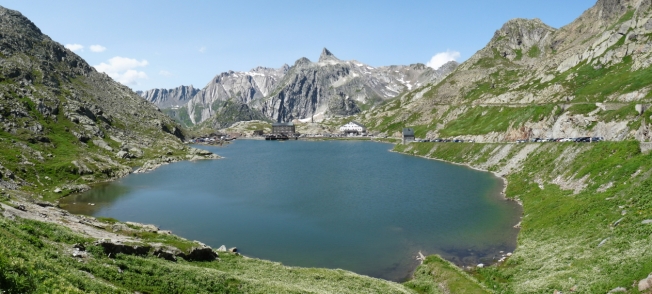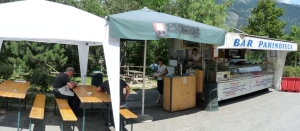Who would have thought that a mountain pass would have been closed in June? Certainly not us, when we were planning our first trip to Europe back in 1991. But sure enough, when we got to the entrance of the Grimselpass, the road from Interlaken towards the Italian lakes, the road was closed. So we had to abandon our plans to visit the Italian lakes, these lakes that had such a reputation for glamour and beauty, long before Mr Clooney was famous, let alone owned a villa there.
This year, we finally made it. Our rental accommodation was nearby, an easy drive to the lakes, and we managed to visit the different lakes about seven times in total. Each time we hopefully packed our swimming togs, but we never found a swimming spot where there was room for even one more car. And on the one day we had decided on a swim and a picnic – planning to head out early to a spot that had looked promising – the heavens opened, and thunder, lightning, and torrential downpours all day scuppered our plans.
Lake Maggiore was the closest lake to us, and the one we visited most frequently. A long, zig-zagged lake that reaches into Switzerland, it is the second largest of the Italian lakes. Our first visit was a quick “reccie” – just checking out what was available. It ended badly, as our rental car’s air-conditioning died. In fact, the fan died as well, just as the car thermometer was telling us it was hovering in the high 30s (it said 40+ but we don’t believe it). So we had to drive home with the windows down, hot air blowing at us, and with the high temperatures, tempers were hot too, particularly when our GPS tried to kill us by sending us up a one-way street. (Fortunately, our proximity to the airport meant we could go to the Hertz office, and swap our car without much fuss. Panic over!)
Our next visit was up the west side of the lake, to popular Stresa and beyond. As usual, we set off late, and decided immediately to start looking out for some lunch spots. At Lesa, before Stresa, we found a nice restaurant right over the lake, with a car park not too far away, and enjoyed some lake trout and a glass of wine. Now, this was more like it. Ferries criss-cross the lake, summer holidaymakers head out on motorboats, and the dark blue-green water is dotted with little white triangles from the sail-boats out enjoying the breeze. Tree-covered hills – it seems wrong to say mountains when the Alps are so close – rise up steeply from much of the lake, giving it drama and beauty. And lovely villas – some now hotels – and gardens line the shore. This was what we had hoped to see in 1991.
We returned to Lake Maggiore twice more. Once to take a ferry across to one of the more northern towns. We had plans to visit one of the garden islands, but frankly, we were tired from a long day driving the previous day, and we enjoyed pottering through the streets of Verbania, looking in some of the shops, and enjoying another delicious lunch on a terrace right by the lake. Our other visit to the lake was back to Laveno-Mombello (isn’t that a great name?), to take the cable car recommended by some English guys who rent a flat near us and fly for Easyjet. Cable car is, however, a rather grand name for what turned out to be a large bucket, just enough room for two, dangling from a cable, scaling a mountain (if I climbed it, in a bucket or not, it’s a mountain not a hill). At the top however was a restaurant (of course) with a most spectacular view. We decided a bottle of wine was appropriate here, after the journey up, and took our time over a pleasant lunch, in slightly cooler temperatures than at the lake below. You can see a theme beginning to develop here, I’m sure.

Lake Maggiore from our lunch terrace

Lake Maggiore – call that a cable car? More like cable buckets.

Lunch on Lake Maggiore

Fish ravioli at Laveno-Mombello
Lake Como was, of course, a must visit during any stay in the Italian lakes region. Como itself was a pleasant enough town, with piazzas, gardens, statues, and naturally, a duomo. But the attraction of the area is of course the lake itself. Here the lake is narrower than Maggiore, and the hills seemed steeper, the villages forced closer to the shores of the lake, making for much better picture-taking. Rather than take a slow ferry ride, we opted to drive up to Bellagio for lunch – about half-way up the lake. The road on the map looked a reasonable size, and was shaded green for “scenic” so that sounded promising. We soon found though that the road was made for horses and buggies, or maybe a few tiny Italian cars. So it was a slow drive, hair-raising at times, when passing trucks or large cars down from Germany for the summer. The road rose to give us beautiful views of the lakes, sneak peeks into large villas (was that George I saw?) with large gardens and grand entrances, through old villages where the streets narrowed even further, and finally to Bellagio, where some patience, and a slight argument with an Italian, scored us a park.
Bellagio is a beautiful little village right on the lake, a stop for the ferries, with a villa and gardens you can visit. We thought about it, the gardens looked attractive, but there was a hotel with a terrace over the lake, and the perch risotto was calling to us (me). Besides, after that drive, some wine was necessary. (Don’t worry – a long lunch, and afterwards a walk and compulsory gelato, saw the driver sober enough to navigate the narrow windy roads to get us home).

Lake Como – view from our lunch table

Lake Como

Lunch in Lake Como

Lake Como – a seagull hoping for lunch scraps

A church impossibly high near lake Como
As much as we liked Como, our favourite lake was the smallest and least well known, Lago d’Orta (Lake Orta). To the west of Lake Maggiore, separated just by a mountain or two, Lake Orta’s main feature is the island of Isola di San Giulio (Island of Saint Julius). We visited the island, where Saint Julius supposedly built his last of 100 churches in the fourth century. Now home to Benedictine nuns, there is a Walk of Silence, through the old buildings and with peeks out at the lake and back to the town. However, the medieval town of Orta San Giulio, where you board the ferries to the island, was also a highlight. A lakefront piazza, a Wednesday market (though disappointingly set up for tourists rather than locals), lots of little shops and restaurants and gelaterias, made for a very relaxing and pleasant atmosphere. Lunch (yes, again – it saved us from cooking dinner in the evening in the heat) on a terrace overlooking the island was relaxing, and delicious. I never expected to find great food in the touristy Lakes region, but this was the good quality Italian food we never found in Rome. Before we headed home, we visited a park above the town, overlooking the lake. A UNESCO World Heritage Site, the Sacro Monte (Sacred Mountain) is a park filled with about 20 chapels, built in the 16th-18th century. The chapels were interesting, the temperature was cooler, and the views … well, the views were spectacular.

Isola San Giulio in Lake Orta

Isola San Giulio – from the ferry

Benedictine nuns returning to their island

Lunch in Orta – burrata and tomatoes

Sacro Monte – one of the 20 chapels
It may have taken 22 years to get here. But the wait was worth it.







































